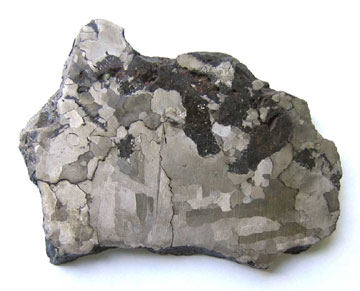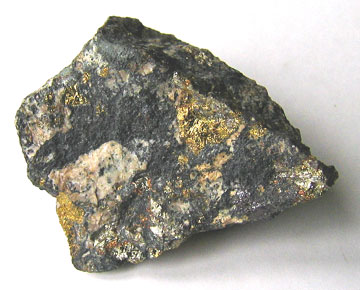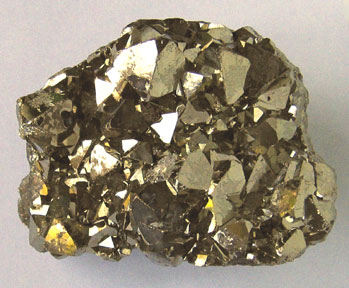Welcome to Roger Russell's
Gold Reference Page
Copyright 1996-2006 by Roger Russell
All rights reserved
No portion of this site may be reproduced in whole or in part
without written permission of the author.
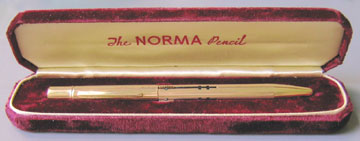
 Since becoming involved with several different products
involving gold, I really needed more information about this element and it's
various uses. I found that Norma gold
pencils could be made as either gold filled or rolled gold. Electrical connectors
are now almost always gold plated. It provides near corrosion free contacts
that increase the reliability in audio, computer and other communications
equipment.
Since becoming involved with several different products
involving gold, I really needed more information about this element and it's
various uses. I found that Norma gold
pencils could be made as either gold filled or rolled gold. Electrical connectors
are now almost always gold plated. It provides near corrosion free contacts
that increase the reliability in audio, computer and other communications
equipment.
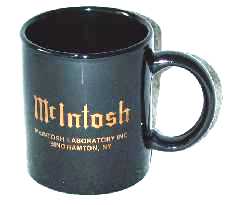 In designing souvenir
mugs I found that gold lettering was available instead of
normal colored ink. At first the lettering was done with 22k gold leaf.
However, gold leaf is electrically conductive. When placed in a microwave oven,
currents are induced and can burn out the gold leaf or even possibly damage
some microwave ovens. To overcome this, a gold ink has been developed that is
made of fine gold particles that are insulated from each other. The result is
gold lettering that is non-conductive and safe for microwave use.
In designing souvenir
mugs I found that gold lettering was available instead of
normal colored ink. At first the lettering was done with 22k gold leaf.
However, gold leaf is electrically conductive. When placed in a microwave oven,
currents are induced and can burn out the gold leaf or even possibly damage
some microwave ovens. To overcome this, a gold ink has been developed that is
made of fine gold particles that are insulated from each other. The result is
gold lettering that is non-conductive and safe for microwave use.
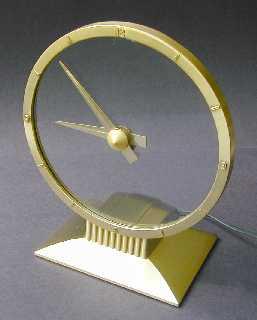 Several different clocks that are thought to be brass
or brass plated are actually 24k gold plated. One such clock was made by Jefferson Electric. It
was appropriately called the Golden Hour clock. About 2 million of these were
sold over a 41 year period starting in December of 1949.
Several different clocks that are thought to be brass
or brass plated are actually 24k gold plated. One such clock was made by Jefferson Electric. It
was appropriately called the Golden Hour clock. About 2 million of these were
sold over a 41 year period starting in December of 1949.
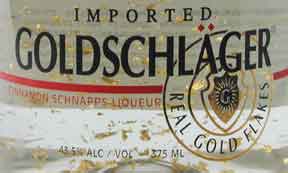 Of course there are many more uses than just these
few. One of the more unusual applications is for flakes of gold leaf in a
cinnamon schnapps liqueur called Goldschlager. Many years ago this inspired
John L. Hancock, a clock designer at Mastercrafters Clock and Radio Company, to
design the Action Starlight clock. It contained two tubes of viscous fluid with
metal flakes. The tubes were illuminated and heated by lamps underneath causing
the flakes to circulate.
Of course there are many more uses than just these
few. One of the more unusual applications is for flakes of gold leaf in a
cinnamon schnapps liqueur called Goldschlager. Many years ago this inspired
John L. Hancock, a clock designer at Mastercrafters Clock and Radio Company, to
design the Action Starlight clock. It contained two tubes of viscous fluid with
metal flakes. The tubes were illuminated and heated by lamps underneath causing
the flakes to circulate.
![]()
Gold has been considered to be valuable for at least 5000 years and perhaps much further back in time. It has been prized for it's rarity, beauty, easy workability and indestructibility. Besides the physical qualities of gold, the Egyptians valued it as symbolic of the gods. Early use of gold was accomplished by finding nuggets and hammering them into shape without melting them. In the days of the pyramids, Egypt was known for being rich in gold. Rocks from the mines were broken up, ground and then panned the same as the way it was done in the gold rush days. Later, as technology improved, it was melted and often alloyed with other metals to give it greater strength and better malleability for use as jewelry, utensils or coins. We also know about the gold rushes in California, Australia and Africa.
The average demand for gold in the past 10 years has been mainly for jewelry at 76%, followed by industrial applications of 14% and 10% for investors. The top ten gold producing countries are South Africa, United States, Australia, Canada, China, Indonesia, Russia, Peru, Uzbekistan and Ghana. The available gold supply is from new mining, reclaimed scrap, official or new bank sales and gold loans made from official reserves. There are five international trading centers: New York, London, Zurich, Tokyo and Hong Kong.
![]()
Of course, most of us have heard about the quest for gold by the European countries and what they took in the empires of the Mayans, Incas and Aztecs. Then there were the treasure ships that never made it back home and the treasure hunters that have recently discovered a few of these wrecks. One of these treasure hunters was Mel Fisher who finally found the Spanish ship Itocha that sank near the Florida Keys. There is now a museum and sales shop located on Key West.
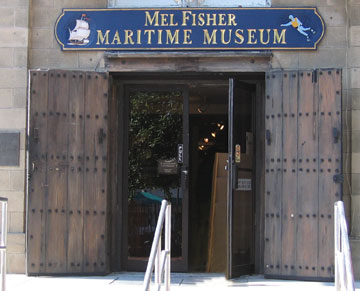
I visited the Mel Fisher Museum and Sales Shop in 2005 and was very impressed with the display. There were two floors showing a wide variety of artifacts that had been recovered. There was also a gift shop and store where you could purchase certified gold and silver coins that had been recovered, were on consignment or were non-shipwreck.

The few coin prices I saw ranged between $3500 and $20,000. The price depended on the condition, rarity, weight, etc. Some had been mounted with a clasp and chain.
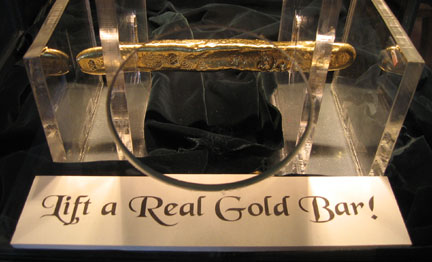
One of the recovered gold bars was on display in an enclosed clear plastic box. A hole in the center allowed you to reach in and actually lift a real piece of the recovered gold. Of course, it was surprisingly heavy.
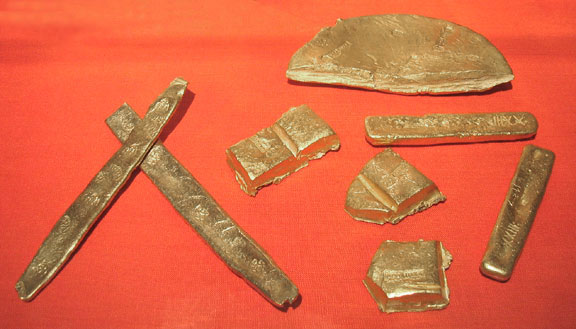
Gold
Finger Bars
Recovered from the Spanish Nuestra Senora de Atocha
“216 gold bars, discs and chunks have so far been recovered from the (year 1622) galleons, but there may well be more still waiting to be discovered. Although the cargo manifest recorded the official quantity of gold bars carried on board, many bars were not marked with the royal stamp showing payment of taxes. These were contraband. If caught, the smuggler of a contraband bar could face sentence as a galley slave. Bars like the ones displayed here were called “finger” bars because of their shape, or “boot” bars because they could easily be hidden in a man’s boot.”
![]()
The universal standard for weighing gold is the Troy ounce, about 1.1 avoirdupois (ordinary) ounces. The term karat is used to designate the proportion of fine gold in an alloy. (This is not to be confused with the term carat that is the unit of weight used to measure gems.) Gold in it's purest state is 24/24ths gold or 24 karat 100% pure gold. However, it can be alloyed with other metals. For instance 18k is 18/24ths gold or 75% gold and 25% other metals.
|
American Marking |
% Fine Gold |
European marking |
|
24k |
100% |
.999 |
|
22k |
91.6% |
.916 |
|
18k |
75% |
.750 |
|
14k |
58.5% |
.585 |
|
10k |
41.6% |
.416 |
Based on 1976 information, 10k is the legal minimum accepted standard of gold karatage in the USA, with 14k being the most popular. In France and Italy, 18k is the lowest permissible standard to be called gold. England accepts 9k gold, while in some countries of the world, 8k is the legal minimum standard.
Gold can be alloyed in a range of colors but only a few alloys have the right combination of strength, beauty and workability to qualify for use in jewelry.
Most jewelry contains a mixture of at least
two other metals. To retain gold's natural color and increase it's hardness, it
is alloyed with a combination of copper and silver. Green gold is achieved when
silver, and sometimes small amounts of copper and zinc are used as alloys. A
pink or red tint results when gold is alloyed with copper. White gold is made
by combining 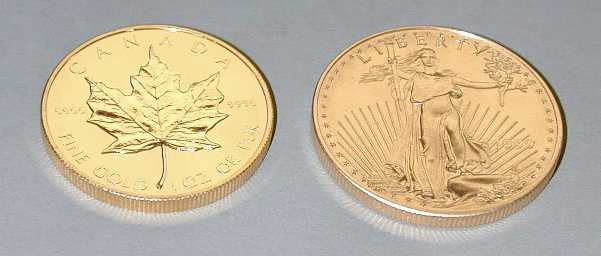 gold with copper, nickel and zinc.
gold with copper, nickel and zinc.
Small amounts of alloy metals can make a noticeable difference in the color of these coins. For instance: at the left side of the picture is a Canadian maple leaf coin that is 99.99% gold. The coin on the right is an American bullion Eagle that is 91.67% gold plus copper and silver. The pure gold is noticeably yellow in comparison. Because the American eagle is alloyed, I will show less wear over time. In comparison, the pure gold Canadian maple leaf will show wear and scratches much more easily.
![]()
Gold Filled--A process by which a layer of at least 10k gold has been mechanically bonded to a base metal. this layer must constitute at least 1/20th of the total weight of the metal in the piece. Items must be marked gold filled preceded by the karat fineness of the plating. e.g. 14k gold filled.
Rolled Gold Plate--Same as gold filled except the quantity of karat gold is less than 1/20th of the total metal weight. It must be identified with a fraction indicating the quantity of gold, e.g. 1/40 12k R.G.P.
Solid Gold-- A term that some would reserve for fine or 24k gold because it contains no other metals. However, in 1967 the federal Trade Commission held that solid gold may be used to describe articles that do not have a hollow center and are 10k or finer.
Gold Leaf--Developed by Egyptians 6500 years ago. Gold can be beaten to a thickness of only 4 microns and used for many different ornamental purposes..
Troy Ounce--Part of the system of Troy weight used for measuring metals based on a pound having 12 ounces and is 31.103 grams per ounce. Gold is measured worldwide in Troy ounces.
Avoirdupois Ounce--Based on a pound having 16 ounces and an ounce having a weight of 28.349 grams.
![]()
Gold, Gold Coins and the United States
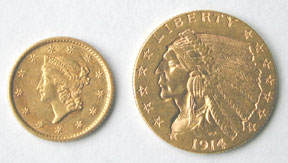 Gold was a recognized medium of exchange in the United States
until Franklin Delano Roosevelt became president on March 4, 1933. Drastic measures were needed to restore the economy
from the great depression. His first official act was to order the confiscation
of privately owned gold. On April 5, 1933 and executive order was issued demanding complete
surrender of gold coins, gold bullion and gold certificates still in possession
of individuals. The owners had 25 days to turn their gold into a federal
reserve bank. Failure to comply was punishable by a fine of $10,000 or 10 years
in prison or both. All safe deposit boxes in banks or financial institutions
were sealed and could only be opened in the presence of an agent of the
Internal Revenue Service. He outlawed the export of gold coin and bullion and
placed an embargo on all international gold dealings. He arbitrarily fixed the
price of gold, which had been set at $20.67 per fine ounce for ninety-six
years, at $35.00 per ounce. However, persons surrendering gold to the
government received only the former price of $20.67 per ounce. In return, they
received paper money, whether they liked it or not. Congress declared all
voluntary, private agreements to pay and to be paid in gold—past, present and
future—to be void. These steps did help to restore the economy but at the price
of stripping money from a gold backing and creating the seeds of inflation. One
exception was rare and unusual coins with special collector value. In 1954 the
Treasury Department amended the gold regulations to enable the continuance of
the exemption of rare coins and extended the definition to include gold coins
made prior to April 5th, 1933.
Gold was a recognized medium of exchange in the United States
until Franklin Delano Roosevelt became president on March 4, 1933. Drastic measures were needed to restore the economy
from the great depression. His first official act was to order the confiscation
of privately owned gold. On April 5, 1933 and executive order was issued demanding complete
surrender of gold coins, gold bullion and gold certificates still in possession
of individuals. The owners had 25 days to turn their gold into a federal
reserve bank. Failure to comply was punishable by a fine of $10,000 or 10 years
in prison or both. All safe deposit boxes in banks or financial institutions
were sealed and could only be opened in the presence of an agent of the
Internal Revenue Service. He outlawed the export of gold coin and bullion and
placed an embargo on all international gold dealings. He arbitrarily fixed the
price of gold, which had been set at $20.67 per fine ounce for ninety-six
years, at $35.00 per ounce. However, persons surrendering gold to the
government received only the former price of $20.67 per ounce. In return, they
received paper money, whether they liked it or not. Congress declared all
voluntary, private agreements to pay and to be paid in gold—past, present and
future—to be void. These steps did help to restore the economy but at the price
of stripping money from a gold backing and creating the seeds of inflation. One
exception was rare and unusual coins with special collector value. In 1954 the
Treasury Department amended the gold regulations to enable the continuance of
the exemption of rare coins and extended the definition to include gold coins
made prior to April 5th, 1933.
Pictured at the left are the $1.00 Liberty Head and the $2-1/2 Indian head coins. The Liberty was minted between 1849 and 1929 in 3 different types. The Indian was minted from 1908 to 1929. It has a reverse or indented relief.
By 1945, gold reserves for federal Reserve Notes and deposits decreased from 35% to 25%. The year 1964 saw the last time silver coins were minted by the government. Up until 1968 the price of gold was fixed at $35 an ounce. After that, prices rose sharply. In 1971 Nixon ended the redeemability of federal Reserve notes and deposits. On December 31, 1974, the U.S. federal government lifted a 41-year ban on the private ownership of gold. Around that time gold was being traded on the London bullion market at record highs approaching $200 an ounce. After subsequent sharp decreases, prices rose to a high of $850 in January 1980. They then dropped considerably and in the early 1990s settled at about $370 an ounce. The price of gold today still varies today. It was below $300 in the late 90’s but the current trend is now above $300 and, of course, varies from one minute to the next.
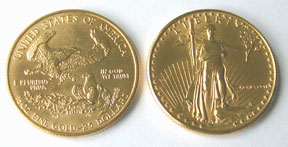 In 1986, the US government began issuing the Gold Eagle bullion
series of coins. They are available to anyone through coin dealers. These coins
are minted in the 1 oz, 1/2 oz, 1/4 oz and 1/10 oz weights. The corresponding
marked legal tender value is $50, $25, $10 and $5. The face value is mainly
symbolic since the value of gold has been much higher. Millions of these coins
have been sold since they were first issued. Because they are backed by the US
Government, they are considered a safe investment worldwide. The coins are 22k
made from gold mined in the United States. The composition is 91.67% gold, 5.33% copper, 3%
silver. These proportions have been chosen to harden them to resist scratching
and marring.
In 1986, the US government began issuing the Gold Eagle bullion
series of coins. They are available to anyone through coin dealers. These coins
are minted in the 1 oz, 1/2 oz, 1/4 oz and 1/10 oz weights. The corresponding
marked legal tender value is $50, $25, $10 and $5. The face value is mainly
symbolic since the value of gold has been much higher. Millions of these coins
have been sold since they were first issued. Because they are backed by the US
Government, they are considered a safe investment worldwide. The coins are 22k
made from gold mined in the United States. The composition is 91.67% gold, 5.33% copper, 3%
silver. These proportions have been chosen to harden them to resist scratching
and marring.
At first, I didn't understand the nature of these coins. For instance, on the largest gold eagle coin it says "1 ounce fine gold," but it weighs 33.930 grams and 1 Troy ounce is 31.103 grams. So what accounts for the missing 2.827 grams? The gold is 22k and not 24k. The pure gold content is 91.67% of 33.930 grams or 31.103 grams, exactly one Troy ounce. The remainder is the alloying metals.
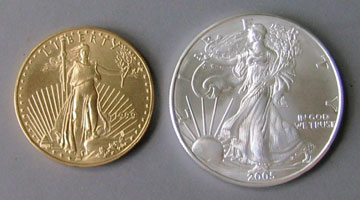 Other popular bullion coins available today include
the Australian Kangaroo Nugget, the Austrian Philharmonic, The Canadian Maple
leaf and the South African Krugerrand. Investment coins are valued only by the
current price of gold whether they are circulated, proof or not.
Other popular bullion coins available today include
the Australian Kangaroo Nugget, the Austrian Philharmonic, The Canadian Maple
leaf and the South African Krugerrand. Investment coins are valued only by the
current price of gold whether they are circulated, proof or not.
Silver eagles were also made available. Both coins at the right contain 1 ounce of pure metal. Because the silver density is less than the gold, a greater volume of silver is needed to make one ounce and a larger coin results. Silver has also been used in money, jewelry, etc. However, the value of silver may have always been less than gold. Today, it is only about one fiftieth of the value of gold.
Collectible Gold Coins
Numismatic, or collector coins, are valued for rarity, age and condition. These can be proof sets and/or low mintage items and can sell for much higher prices. They are sought for their beauty and historical significance. They can be an investment in the sense that the collector value may go up. The history of these coins is very interesting. It includes information about the designer, how many were minted, when and where they were minted, composition, etc. Typically, the coins are certified, graded and available enclosed in a sealed clear plastic container.
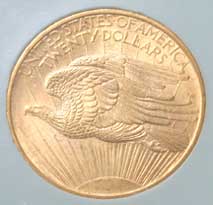 One such history is about the St. Gaudens coin. In
late 1905 President Theodore Roosevelt asked Augustus St. Gaudens, a famous
American sculptor, to redesign the $10.00 eagle and the $20.00 double eagle.
The result is one of America's most attractive coins.
One such history is about the St. Gaudens coin. In
late 1905 President Theodore Roosevelt asked Augustus St. Gaudens, a famous
American sculptor, to redesign the $10.00 eagle and the $20.00 double eagle.
The result is one of America's most attractive coins.
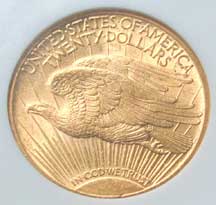 However, there were two different versions of this
coin. Roosevelt believed that it was offensive to have "In God
We Trust" on the nation's coins. This could have been interpreted as an
emphasis toward separation of church and state but Roosevelt's
reasoning was that it was nearly blasphemous to use God's name on coins that
might be used for immoral or illegal purposes. Accordingly, coins minted
between 1907 and 1908 did not have this motto (picture at the left). This is
despite the fact that back in 1865; legislation directed that the motto be
placed on all coins large enough to allow it. Soon after, in 1908, Congress
insisted on reinstatement and the motto was again used (picture at the right).
However, there were two different versions of this
coin. Roosevelt believed that it was offensive to have "In God
We Trust" on the nation's coins. This could have been interpreted as an
emphasis toward separation of church and state but Roosevelt's
reasoning was that it was nearly blasphemous to use God's name on coins that
might be used for immoral or illegal purposes. Accordingly, coins minted
between 1907 and 1908 did not have this motto (picture at the left). This is
despite the fact that back in 1865; legislation directed that the motto be
placed on all coins large enough to allow it. Soon after, in 1908, Congress
insisted on reinstatement and the motto was again used (picture at the right).
The $20.00 St. Gaudens coins contain 90% gold and 10% copper. Total weight is 33.436 grams. The pure gold content is 30.092 grams or 0.9677 troy ounce of pure gold.
![]()
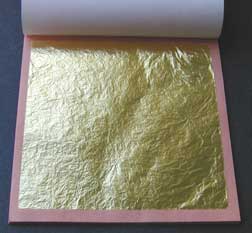 Gold leaf is made by squeezing gold into thinner and
thinner sheets. It can be applied to practically anything with a suitable
adhesive. It can be used on clothing, glass, wood or anything else and have the
appearance of being completely made of gold. Typically it comes in a
"book" of 25 leaves measuring 3-3/8" by 3-3/8". Each sheet
is separated by a piece of neutral paper. Gold leaf is available in various karat
grades up to 24k. The gold is so thin that it often must be handled with a
special brush.
Gold leaf is made by squeezing gold into thinner and
thinner sheets. It can be applied to practically anything with a suitable
adhesive. It can be used on clothing, glass, wood or anything else and have the
appearance of being completely made of gold. Typically it comes in a
"book" of 25 leaves measuring 3-3/8" by 3-3/8". Each sheet
is separated by a piece of neutral paper. Gold leaf is available in various karat
grades up to 24k. The gold is so thin that it often must be handled with a
special brush.
The picture at the left is a typical gold leaf book with the cover folded open and exposing the first sheet. Care must be taken not to breathe too hard on it as it can fly away. This particular gold is 23k. Gold leaf, brushes and adhesives can be purchased at various art stores. This particular book costs about $30.00. It will cover about 2 square feet.
![]()
Where does gold come from? It is formed literally from the stars. Our own sun generates only the lighter elements. Supernovae do emit some heavier elements up to nickel, lead, gold and even uranium. Current thinking is that this accounts for only 5% of the heavy elements. It is thought that infrequent collisions of neutron stars could account for the remainder. Neutron stars are so compact that they contain the mass of the sun in an area the size of a city. When the earth was formed, gold and the other heavy elements were included from the debris in space.
One theory proposes that during the formation of the earth, a very large iron bearing asteroid struck the earth while it was in its molten stage. The asteroid merged to become the core at the center of the earth. Alternately, iron from the debris from space was drawn towards the center. In either case, most of the molten metals were pulled toward the center by gravity, which is why metals are so scarce in the earths crust. The core is composed mostly of iron and nickel plus other elements and it is estimated that 1% of the core contains gold. That adds up to a lot of gold!
|
|
|
Here is a typical iron meteorite (left), perhaps similar in to the debris and/or asteroids that collided with the earth. This one weighs 4-1/2 pounds and came from a fall known as Campos Del Cielo in Northern Argentina, about 500 miles north-northwest of Buenos Aries. The time of fall was 4000 to 6000 years ago. It did not contain any gold but did contain over 92% iron plus 6.68% Ni, 0.43% Co, 0,25% P, 87 ppm Ga, 407 ppm Ge and 3.6 ppm Ir. The crystal formations are shown at the right in a cross section that may have taken millions of years in a vacuum to form. The dark areas are carbon. Meteorites contain the element of Iridium, which is unique to these visitors from space.
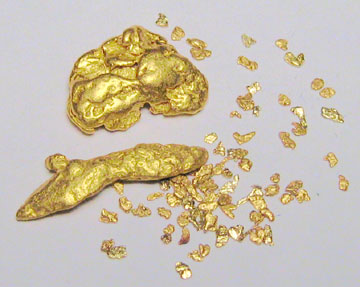
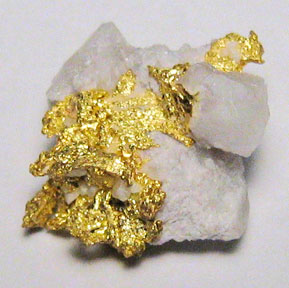 Bacteria in the earth play an integral role in
creating deposits of gold. They can survive far below the ground where there is
no oxygen. Acids secreted by the bacteria break down the rock and mineral ores.
Molecules of gold are attracted to the outer skin of the bacteria. Over the
time of millions of years, the gold builds up to form a glittering gold
deposit. The process of continental drift by the earth's crust and natural
stratification may also contribute to forming veins of gold as well as copper,
silver and other elements that we find in the rock today. Gold is often found
embedded in quartz, shown at the left. This is typical of what could be found
in a gold mine.
Bacteria in the earth play an integral role in
creating deposits of gold. They can survive far below the ground where there is
no oxygen. Acids secreted by the bacteria break down the rock and mineral ores.
Molecules of gold are attracted to the outer skin of the bacteria. Over the
time of millions of years, the gold builds up to form a glittering gold
deposit. The process of continental drift by the earth's crust and natural
stratification may also contribute to forming veins of gold as well as copper,
silver and other elements that we find in the rock today. Gold is often found
embedded in quartz, shown at the left. This is typical of what could be found
in a gold mine.
Even today, gold can be found in creeks and hillsides as it was during the gold rush years and even before. Gold nuggets weighing a few grains to many grams, shown at the right, can be found by panning or with a sluice box. If you are lucky, you can still find large nuggets.
|
|
|
Iron disulfide (FeS2) is a shiny brass-yellow mineral that is common. It is called pyrite or fool’s gold because it has a gold-like appearance and is often mistaken for gold. It can be found imbedded in rock as shown at the left or as a crystalline form shown at the right. It can also be found with impurities such as nickel, which is called Bravolite. Although pyrite contains much iron, it has not been as economical to mine as other iron ores.
The mention of fool’s gold reminds me of the movie The Treasure of the Sierra Madre (1948) with Walter Huston and Humphrey Bogart
![]()
Gold
|
Chemical Symbol Au |
Atomic Number 79 |
A comparison with other elements
|
Element |
Atomic weight |
Density |
|
Zinc |
65 |
7.1 |
Links
About This Site
|
More text and pictures about gold will be added as my research continues. |
|
|
Any comments, corrections, or additions are welcome. |
|
|
Created by Roger Russell |
|
|
All contents are copyright 2000-2006 |
|
|
|

